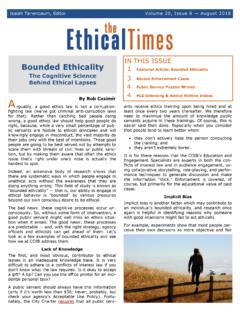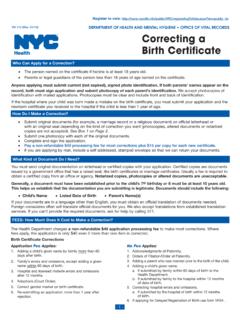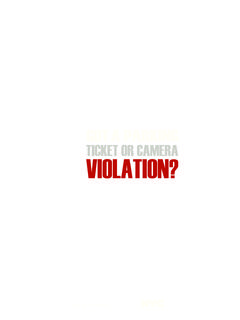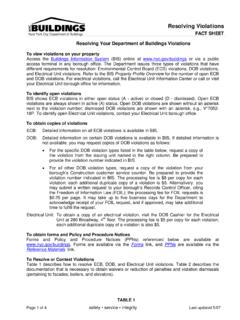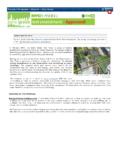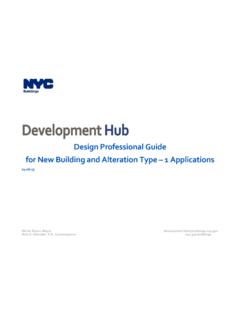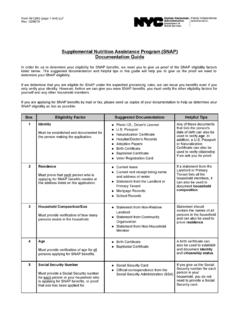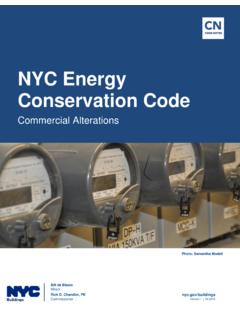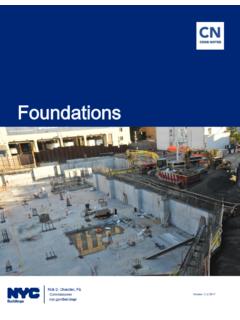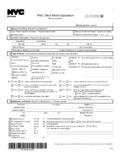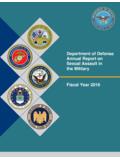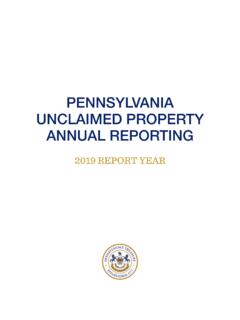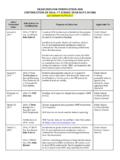Transcription of HIV SURVEILLANCE ANNUAL REPORT, 2016 - nyc.gov
1 HIV SURVEILLANCE ANNUAL report , 2016 HIV SURVEILLANCE NEW YORK CITY DEPARTMENT OF HEALTH AND MENTAL HYGIENECONTENTSEXECUTIVE SUMMARYSECTION DESCRIPTIONPAGE1 HISTORY OF THE EPIDEMIC12 HIV DIAGNOSES OVER TIME13 DEMOGRAPHIC AND CLINICAL CHARACTERISTICS24 GEOGRAPHIC DISTRIBUTION OF HIV35 HIV AMONG MALES46 HIV AMONG FEMALES57 NEW HIV DIAGNOSES BY GENDER, AGE, RACE/ETHNICITY, AND RISK68 HIV AMONG TRANSGENDER PEOPLE79 HIV AMONG CHILDREN710 ACUTE HIV INFECTION811 ESTIMATED HIV INCIDENCE812 PREP AND PEP USE AMONG PEOPLE NEWLY DIAGNOSED WITH HIV913 TRANSMITTED DRUG RESISTANCE914 HIV CARE1015 NYC HIV CARE CONTINUUM 1116 HIV INFECTION STAGING CLASSIFICATION OF PEOPLE LIVING WITH HIV1117 MORTALITY AMONG PEOPLE WITH HIV1218 SURVIVAL AMONG PEOPLE WITH HIV1319 HIV DIAGNOSIS RATES AND STI DIAGNOSIS RATES BY NEIGHBORHOOD1320 HIV PREVALENCE AMONG PEOPLE WHO INJECT DRUGS 1421 SUBSTANCE USE AMONG PEOPLE WITH HIV14 TECHNICAL NOTES15 HIV PROVIDER REPORTING16 ADDITIONAL RESOURCES171 New York State Department of Health.
2 2015 Blueprint to End the AIDS Epidemic, State of New York: Albany, NY. March Epidemiology and Field Services Program. HIV SURVEILLANCE ANNUAL report , 2015. New York City Department of Health and Mental Hygiene: New York, NY. December report presents 2016 SURVEILLANCE data on the HIV epidemic in New York City (NYC). It includes graphic trends in HIV diagnoses over time for key populations, geographic distribution of HIV in NYC, and key outcomes such as linkage to care, viral suppression, and survival among people with HIV (PWH). New features include data on pre and post exposure prophylaxis (PrEP and PEP) use among people newly diagnosed with HIV, HIV infection staging of NYC PWH, trends in underlying cause of death among PWH, sexually transmitted infection (STI) diagnosis rates in neighborhoods with high HIV diagnosis rates, HIV testing history and HIV prevalence among people who inject drugs, substance use among NYC PWH, and the NYC HIV Care and data driven efforts to end the HIV epidemic in New York1are ongoing and progress is evident in reducing new HIV diagnoses in NYC and improving outcomes for PWH in NYC.
3 The ANNUAL number of new HIV diagnoses continues to decline, from 2,493 in 20152to 2,279 in 2016 (an decrease). In 2016 , new HIV diagnoses among men who have sex with men (MSM) reached a statistically significant low for the first timesince 2001 when HIV reporting began in New York. 2016 had the steepest year to year drop in new HIV diagnoses among MSM, declining from 1,450 in 20152to 1,236 in 2016 ( decrease). White, Black and Latino/Hispanic MSM experienced declines in new HIV diagnoses from 2015 to 2016 , withthe largest decreases among Whites and Latinos/Hispanics. The all cause mortality rate and rate of HIV related deaths among PWH continue to decline. Nearly two thirds of deaths amongPWH in NYC are now attributed to a non HIV related cause. Overall, 76% of all estimated PWH in NYC were virally suppressed in 2016 . Of those in care, 84% were virally suppressed in 2016 (up from 76% in 2012).Despite these successes, disparities by gender, race/ethnicity and transmission risk persist.
4 Women with HIV in NYC continue tobe overwhelmingly women of color, with Black and Latina/Hispanic women comprising of all new diagnoses amongwomen in 2016 . While HIV diagnosis rates continue to decline for Black, Latino/Hispanic, and White men, HIV diagnosis rates forwomen from all racial groups increased from 2015 to 2016 . Nearly two thirds ( ) of new HIV diagnoses among men withknown transmission risk were in MSM of color, while a similar proportion ( ) of new diagnoses among women were inheterosexual women of color age 30 and and PEP use among people newly diagnosed with HIV was generally low (2% and 1%, respectively), but use patterns revealdisparities that cut along gender, race/ethnicity, age, and transmission risk categories. Substance use remains a significant clinicaland public health concern for PWH; data included in this report demonstrate poorer viral suppression among PWH who reportsubstance use. Finally, neighborhood level analysis of HIV and STI diagnosis rates underscores opportunities to improve access toPrEP for women and ,00040,00060,00080,000100,000120,000140, 00002,0004,0006,0008,00010,00012,00014,0 0019811982198319841985198619871988198919 9019911992199319941995199619971998199920 0020012002200320042005200620072008200920 1020112012201320142015* 2016 Number of Reported PLWHAN umber of New HIV/AIDS Diagnoses and DeathsHIV DIAGNOSES OVER TIMEHISTORY OF THE EPIDEMICFIGURE.
5 History of the HIV epidemic, NYC 1981 2016 New HIV DiagnosesReported People Living with HIV (non AIDS) Reported People Living with AIDSNew AIDS DiagnosesHIV Related DeathsAIDS case reporting mandated by NYSCDC AIDS case definition (23 OIs) implementedAIDS case definition expanded(CD4 <200, 26 OIs)HAART introducedNYS expands AIDS reporting to include HIVNYS HIV reporting law takes effectHIV SURVEILLANCE expands to include all HIV related laboratory reportsFIGURE : Trends in HIV diagnoses, NYC 2001 2016 HIV related cause of death reporting beginsNYS mandates routine offer of HIV testPLWHA=People living with HIV/AIDS*Data on 2016 deaths are incompleteART for all PLWHA recommended; FDA approves PrEPThe number of new HIV diagnoses reported in New York City from 2001 to 2016 decreased overall and by gender, race/ethnicity, age at diagnosis, borough of residence, and transmission risk. This decrease is significant (P value < ) for all subgroups except transgender people, Asian/Pacific Islanders, and transgender people with sexual contact.
6 HIV Diagnoses20012016 EAPCP ValueTotal5,9062,279 < ,9151,771 < ,944462 < 3,096991 < ,780768 < < American136 < Group (Years)0 123021 < 1919579 < 291,125803 < 392,098603 < 491,546408 < 59635263 < +221122 < Diagnoses20012016 EAPCP ValueBorough of ResidenceBronx1,342520 < ,630581 < ,528468 < < Island10361 < NYC425207 < RiskMen who have sex with men (MSM)1,7101,236 < drug use history (IDU)85832 < IDU12428 < contact1,468386 < people with sexual < = Estimated ANNUAL percent change1 TABLE : HIV/AIDS diagnoses and deaths occurring January 1, 2016 , through December 31, 2016 ; and people diagnosed with HIV/AIDS, reported in NYC, and presumed to be living as of December 31, 2016 DEMOGRAPHIC AND CLINICAL CHARACTERISTICSIn 2016 , there were 2,279 new HIV diagnoses and 1,265 new AIDS diagnoses in New York City.
7 As of the end of 2016 , 123,887 people had been diagnosed with HIV/AIDS, reported in New York City and were presumed to be living. As of March 31, 2017, there were 1,403 deaths reported among people with HIV in Diagnoses1 AIDS Diagnoses3 PLWHA as of12/31/ 2016 Deaths4 TotalWithout AIDSC oncurrent with AIDS Diagnosis2N%N %N%Row %N% N%N%Total2,279 1, 411 1,265 123,887 1,403 ,771 1, 307 ,397 101 ,253 , 197 ,302 123 ,375 53 ,635 , Group (years)60 29803 80 , 39603 107 ,308 49408 122 ,462 59263 59 ,696 + ,322 of Residence7 Bronx520 99 ,803 110 ,738 76 ,476 88 ,307 , , Based Poverty Level8 Low poverty (<10% below FPL) ,985 poverty (10 to <20% below FPL)
8 624 113 ,364 poverty (20 to <30% below FPL)535 108 ,900 high poverty ( 30% below FPL)707 131 ,054 based poverty level not available241 ,584 risk9 Men who have sex with men (MSM)1,236 1, 158 ,357 drug use history (IDU) ,594 , contact386 84 ,383 people with sexual , , 161 ,014 living with HIV/AIDS; FPL=Federal Poverty Level. All percents are column percents unless otherwise indicated. 1 Excludes people known to have been diagnosed outside of NYC. 2 HIV diagnosed concurrently with AIDS (within 31 days of HIV diagnosis). Row percent is percent of total HIV diagnoses that were concurrent with AIDS diagnoses. 3 AIDS was diagnosed in 2016 and includes concurrent HIV/AIDS diagnoses. 4 Includes deaths from any cause in people with HIV/AIDS. Death data for 2016 are incomplete.
9 5 For technical notes on race/ethnicity: 6 For HIV and AIDS diagnoses, age at diagnosis; for PLWHA, age as of December 31, 2016 ; and for deaths, age at death. 7 For HIV and AIDS diagnoses, residence at diagnosis. For PLWHA and deaths, residence based on most recent record available (most recent record is >5 years old for 26% of PLWHA in 2016 ).8 Area based poverty based on NYC ZIP code of residence at diagnosis or most recent residence (see footnote 7). 9 Heterosexual contact includes people who had heterosexual sex with a person they know to be HIV infected, an injection drug user, or a person who has received blood products. For females only, also includes history of sex work, multiple sex partners, sexually transmitted disease, crack/cocaine use, sex with a bisexual male, probable heterosexual transmission as noted in medical chart, or sex with a male and negative history of injection drug use. Transgender people with sexual contact includes people identified as transgender by self report , diagnosing provider or medical chart review with sexual contact reported and negative history of injection drug use.
10 Other includes people who received treatment for hemophilia, people who received a transfusion or transplant, and children with non perinatal transmission risk. 2 FIGURE :Poverty level, NYC 2011 2015 FIGURE : HIV diagnosis rates, NYC 2016 GEOGRAPHIC DISTRIBUTION OF HIVFIGURE : HIV prevalence, NYC 2016 FIGURE : Age adjusted death rates among people with HIV/AIDS, NYC 2016 PLWHA=People living with HIV/AIDS1 Rates calculated using the intercensal 2015 NYC population. 2 Age adjusted to the NYC Census 2010 population. People newly diagnosed with HIV at death were excluded from the codes in the Chelsea Clinton, Central Harlem Morningside Heights, and East Harlem neighborhoods had thehighest HIV diagnosis rates in 2016 (Figure ). In 2016 , ZIP codes in West Queens, Chelsea Clinton, and CentralHarlem Morningside Heights had the highest HIV prevalence (Figure ). ZIP codes in the South Beach Tottenville,Rockaway, and Stapleton St.
